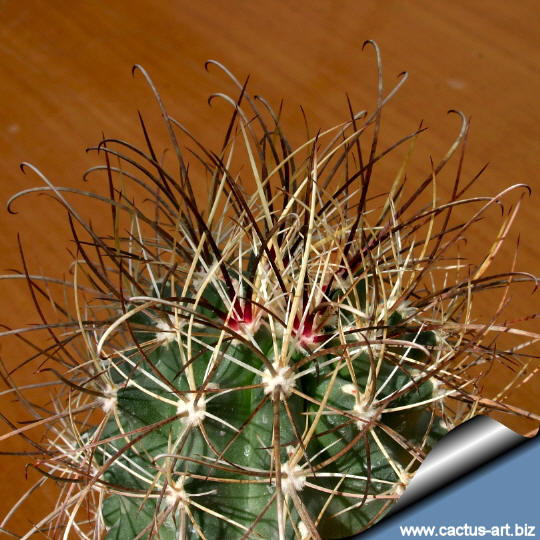|
|
|
Family:
Cactaceae (Cactus
Family)
Scientific name: Sclerocactus
parviflorus ssp. terrae-canyonae K.D.Heil) K.D.Heil & J.M.Porter
Pubblisched in: Haseltonia 2. 20-46.1994.
Basionym: Sclerocactus terrae-canyonae Heil
Pubblisched in: Cact. & Succt. J. (Los Angeles US)
51:25-30.1979
Holotype: Cactaceae Sclerocactus
terrae-canyonae Heil
K.D. Heil, 55-A&B USA: Trachyte Wash, ca. 10 mi S of Natural Bridges
National Monument, San Juan Co., Utah UNM 64283.
Isotype: UNM 64279, SJNM).Sclerocactus
terrae-canyonae Heil
K.D. Heil, 6-A&B USA: Utah, Cact. Succ. J. (Los Angeles) 51: 26 (-28),
figs. 1979. Utah, USA .UNM: 64279
Origin: Northern Arizona, southeastern Utah
Conservation status: Listed in
CITES appendix 2.
Common Name comprise: Longspine Fishhook Cactus,
Devil’s-claw cactus
Synonyms:
- Pediocactus parviflorus ssp. terrae-canyonae (K.D.
Heil) J.J. Halda, Acta Mus. Richnov. Sect. Nat., 5 (1): 16: 1998
- Sclerocactus parviflorus fa. terrae-canyonae (Heil)
Hochstätter
Published in: Cactaceae-Review IRT 1 (1): 4-19, 1998
- Sclerocactus parviflorus Clover & Jotter,
Published in: Bull. Torrey Bot. Club. 68: 419, fig.
8. 1941.
|
|
Description: The Sclerocactus terrae-canyonae is the population of S. parviflorus
with some yellow-flowered individuals, often
referred to as subspecies terrae-canyonae.
But with the exception of the presence of some yellow flowers,
all the other characteristics are absolutely identical, namely size and
form of tubercles, number, size and arrangement of spines, flowers,
fruits and seeds.
S. parviflorus is
the most frequent and well known cactus of the cold American deserts.
Due to its vast region of origin, the plants vary in the amount and
colouring of hooked central spines, as well as in flower colour.
The
scientific classification of this plant has been controverted,
and many
names, forms, subspecies or varieties have been proposed and changed.
Stems: Usually unbranched, but also branched near base,
depressed-spherical, spherical, cylindrical, or elongate-cylindrical,
with tubercles evident on ribs.
Spines: Often obscuring stems; radial spines 8-17 per areole,
usually white, sometimes brown or purplish pink, 6-36 mm; central spines
4-8 per areole, 1-5, hooked, usually purple- black, hooked, 15-72 mm;
lateral spines 2-6 per areole, similar to centrals, usually shorter and
not hooked, usually white (rarely grey, straw-coluoured, pink, or
reddish brown), flat to angled, straight (rarely contorted).
Flowers: The crowns of campanulate flowers in late spring are
spectacular, usually, yellow.
Fruits: green turning reddish pink, with a few scales.
|
|
|
|

|
|
Cultivation: Rarely seen in cultivation,
it needs perfect drainage, and it is quite difficult to grow on its own
roots and to propagate. Mature individuals easily rot and die.
It is indispensable to provide a greenhouse with good ventilation and a
full sun exposure. Keep totally dry during winter. It can tolerate
temperatures below zero (-20° C). Plants grafted on hardy
Opuntia compressa
stock are quite easy to grow, and no special skill is required. In the
spring fertilize periodically, adding a specific fertilizer. Fertilizers
fur succulent plants must be rich in potassium but poor in nitrogen, to
avoid that plants develop excess vegetation, which is easily attacked by
fungal diseases. Water moderately during the growing season, keeping the
soil dry for a few days before watering again.
Propagation:
Seeds are extremely difficult to
germinate (only 2-3 percent of seeds
germinate). Grafting is often used to speed growth rate and to
create a back-up for plants in collection.
Photo of conspecific taxa, varieties, forms and
cultivars of Sclerocactus parviflorus .
|
|